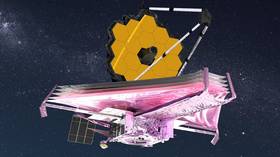NASA reveals status of $10-billion James Webb telescope

Two weeks after its launch, the James Webb Space Telescope has finally unfolded its primary mirror as it begins the final step of its deployment. The telescope is the most powerful device of its kind ever launched into space.
The $10-billion telescope unfolded its honeycomb-shaped primary mirror on Saturday, just over two weeks after its launch from the European Space Agency’s launch base in French Guiana on Christmas Day. Over the past two weeks, the telescope’s reflective silver sunshield and secondary mirror have both been successfully deployed, with the primary mirror the last hurdle in the way of getting the telescope operational.
A 3D rendering shared live by NASA showed the mirror opening up, while engineers back on Earth celebrated.
✅ The final wing is now deployed! Before we celebrate, we’ve still got work to do. The team is working hard at @SpaceTelescope to latch the wing into place, a multi-hour process. When the final latch is secure, #NASAWebb will be fully unfolded in space. #UnfoldTheUniversepic.twitter.com/Rdd7C5LZID
— NASA Webb Telescope (@NASAWebb) January 8, 2022
“I just feel this kind of glow in my chest right now just seeing that mirror deployed all together,” NASA scientist Michelle Thaller said during a live stream by the space agency.
JWST full primary mirror has been successfully deployed! pic.twitter.com/9VZfTpbaNs
— Chris Bergin - NSF (@NASASpaceflight) January 8, 2022
Spanning 6.5 meters (21 feet 4 inches) across and kept at a steady 40 degrees Kelvin (-380°F/-233°C) by the tennis court-sized sunshield, the primary mirror will pick up infrared light from the depths of outer space. Unlike the Hubble Space Telescope, which it replaces, Webb will scan a spectrum of light invisible to the human eye, with the aim of uncovering signs of the first stars and galaxies formed after the Big Bang.
The telescope will also be able to examine the atmospheric composition of exoplanets, aiding the search for Earth-like planets that may harbor life.
Webb is still roughly two weeks away from its final destination at the second Sun-Earth Lagrange Point (L2), some 1.5 million kilometers (a million miles) further away from the sun than Earth. Once there, it will orbit the sun for around 10 years.












